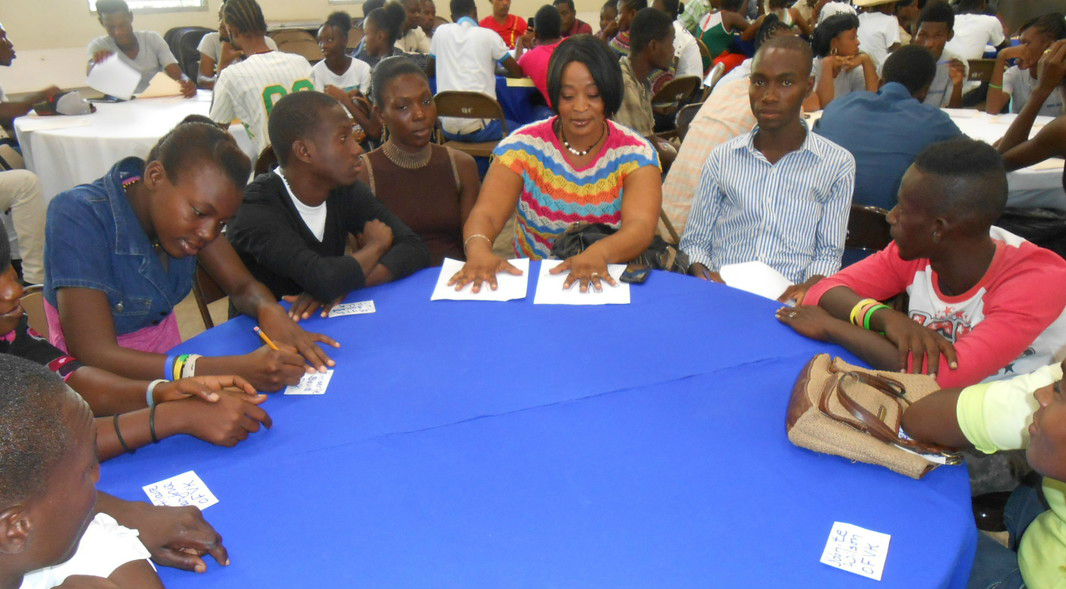
In local peace networks, residents plan projects to improve the safety and health of their communities. Haiti / AFSC
More than six years ago, France Remy was among the one million people who lost their homes in a catastrophic earthquake in Haiti—a disaster that killed more than 200,000 people. After the earthquake, she volunteered as a nurse in a camp in Leogane, where she lived in with many others who had been displaced.
Tensions rose in the camp as residents struggled with loss and scarce resources. France began working with AFSC to address conflicts through nonviolence. Here she shares her experience over the past six years.
 After the earthquake, I began working in the Parc Gerald Christophe camp as a nurse volunteer. My skills were very useful because I specialized in preventing wound infections, and there were a lot of wounded people at the time.
After the earthquake, I began working in the Parc Gerald Christophe camp as a nurse volunteer. My skills were very useful because I specialized in preventing wound infections, and there were a lot of wounded people at the time.
Everyone in Leogane was extremely traumatized. People had lost family and friends. Many had become homeless when their homes were destroyed—this was my case, and I had just finished paying off my house.
At first everyone was very positive and trying tried to help each other. We slept outside and began trying to create makeshift shelters. People from other areas brought assistance like sheets, food, and water.
But it was a time of great worry and anxiety for everyone. There were no jobs, no businesses running, and no schools operating. Conflicts started to occur over access to water. Sanitation began to worsen. Tensions were very high, and people became more aggressive as they realized that their situation would not change soon.
A few months after the earthquake, I got involved with AFSC to address the root causes of these issues. I started working on a project that included psychosocial training, citizen participation, as well as peace building and conflict transformation training.
Learning to live together
During that project, we learned a lot about human resilience. This allowed me to discover many things about myself. I realized that in my life, I was resilient because I had somehow learned to accept whatever situation I was in. I strongly believed that my life was a gift and with it, I could help others to trust that things could be better again.
A woman I knew had lost both of her children in the earthquake. She cried all the time. She would tell me that without them life no longer made sense. The training gave me tools to accompany people like her who needed psychological support.
I also learned about different aspects of conflict transformation and peace building. Before the earthquake, we lived more separately from each other and could avoid many conflicts, but living all together, conflicts were visible almost every day. Using what I learned , I was able to share information with the camp leaders and their family, as well as religious groups and schools, on how to coexist and begin to understand each other. I was able to work with communities to use nonviolent communication to deescalate conflicts and find solutions to problems.
Once there was a conflict because two neighbors who had each covered their house with tarps would accidentally dose the other with water after a heavy rain when they moved the tarp. This caused an enormous dispute as one blamed the other. They did not want to understand that this situation was no one’s fault; it was just part of the reality in which we were living. Everyone in the area met to discuss the real issue and propose solutions. Finally, everyone agreed to help find materials that could correct the problem and rebuild the makeshift roofs in a better way. Every time it rained, we evaluated whether our new construction had given better results. If it did not, we looked for an alternative.
Peace building today

Six years after the earthquake, I think peace building has become even more relevant to our situation today. AFSC’s program will forever be evolving because it builds partnerships within communities. Conflict transformation does not happen in a short period of time; programs need to be developed in ways that respond to situations that are constantly changing.
In Haiti, there are structural conflicts—intense political and social conflicts where youth are manipulated to use violence to further outside interests. We have seen that conflicts in our communities quickly escalate, and it is difficult to predict what may spark violence.
Since the earthquake in 2010, AFSC has developed relationships with 14 community-based organizations in three urban communities. We’ve also developed local peace networks, made up of youth and other community members who meet regularly to reflect, build understanding, and plan projects that promote nonviolence. They also receive trainings on peace building, democracy, human rights, and citizenship.
When I speak to the leaders in the communities where we work, they express to me the importance of our program on different levels. They say it tightens the connections between community members and creates bonds that did not previously exist. Through dialogue, they can build a common vision for their future.